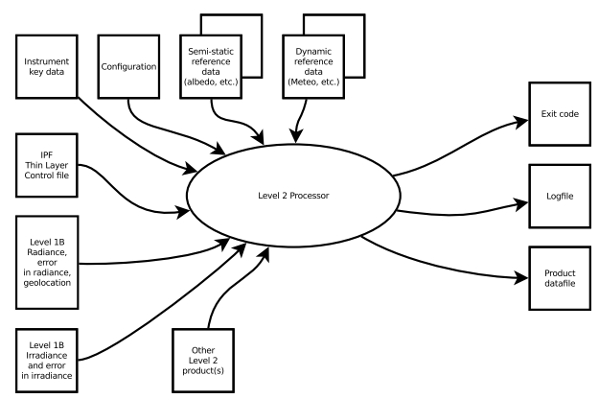The TROPOMI Level-2 processors use Level-1B radiances with geolocations and irradiances. In addition, they will read auxiliary input data, both dynamic (e.g. meteorological fields from a numerical weather prediction model) and static (e.g. absorption cross section reference spectra). Some processors use the Level-2 output from other algorithms. From these inputs the processor will produce a TROPOMI Level-2 output file, for example NO2 columns or O3 profiles. The processors will also produce a log file and an exit code so that the processing system can verify the processing results. A schematic overview of a TROPOMI Level-2 processor is given in Figure 1.

Figure 1: Generic Overview of a TROPOMI Level-2 Processor
A common basis of most TROPOMI processor/algorithms is the computation, at the beginning of the algorithm, of the measured reflectance spectra which is defined by the formula:

Where I(?) is the Level-1B earth radiance spectra, E0(?) the Level-1B sun irradiance spectra and µ0 the cosine of the solar zenith angle.
In most TROPOMI Level-2 algorithms, this measured reflectance spectrum is fitted by a modelled reflectance spectrum in order to retrieve the geophysical (atmospheric concentration, surface albedo) and instrumental (spectral pixels wavelength assignment) parameters of the model at the geolocation (ground pixel coordinate) and time of the measurement.
The algorithms describe the processing of a single ground pixel. In the TROPOMI Level-2 processors, they are integrated in a loop that covers all (valid) ground pixels of the input Level-1B product.
The retrieved Level-2 products based on the UV-VIS-NIR spectral ranges (bands 1 to 6) are:
- HCHO Vertical Column
- SO2 Vertical Column
- NO2 Vertical Columns
- O3 Vertical Profiles
- O3 Total Vertical Column
- Aerosol index
- Aerosol Layer Height
- Cloud Parameters
- Level-2C O3 Tropospheric Vertical Column
Most of them use one of these two main methods:
- Differential Optical Absorption Spectroscopy (DOAS) [e.g. Noxon, 1975 [RD34]; Platt, 1994 [RD32]; Veefkind et al, 2006 [RD31]]
- Optimal Estimation Method (OEM) [e.g. Rodgers, 2000 [RD33]].
Both of these methods have been used for other space-borne, airborne and ground-based remote sensing applications.
The retrieved Level-2 products based on the SWIR spectral range (band 7 and band 8) are:
Before the retrieval of CO and CH4 vertical columns, a SWIR pre-processing module is systematically launched in order to filter cloud-contaminated pixels.
For a complete description of all the TROPOMI Level-2 algorithms, one must refer to the TROPOMI Level-2 ATBD documents available in the Document Library. Each retrieved product has its own ATBD.